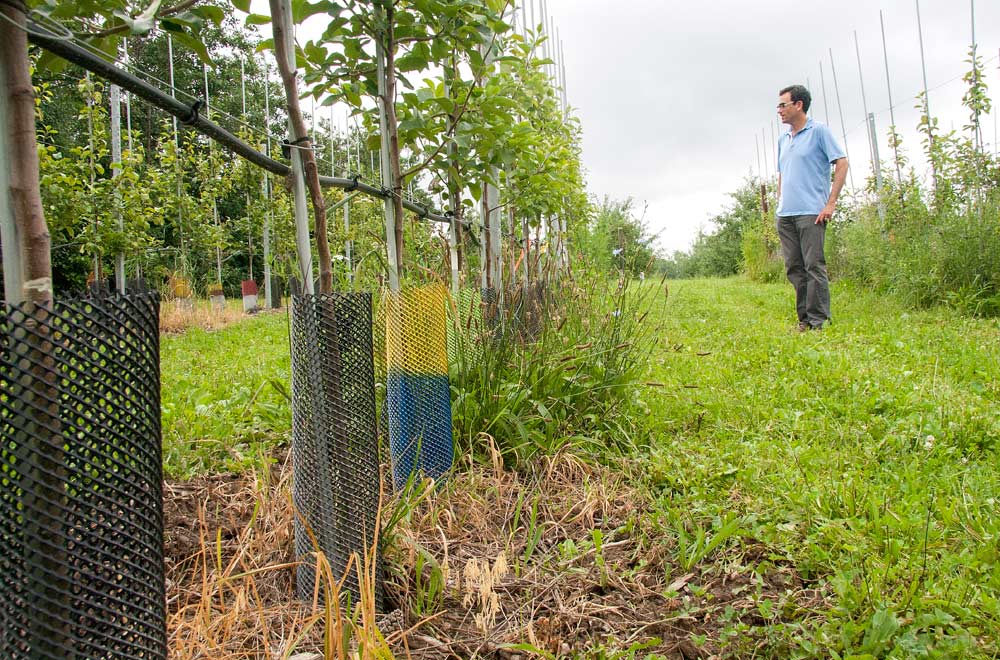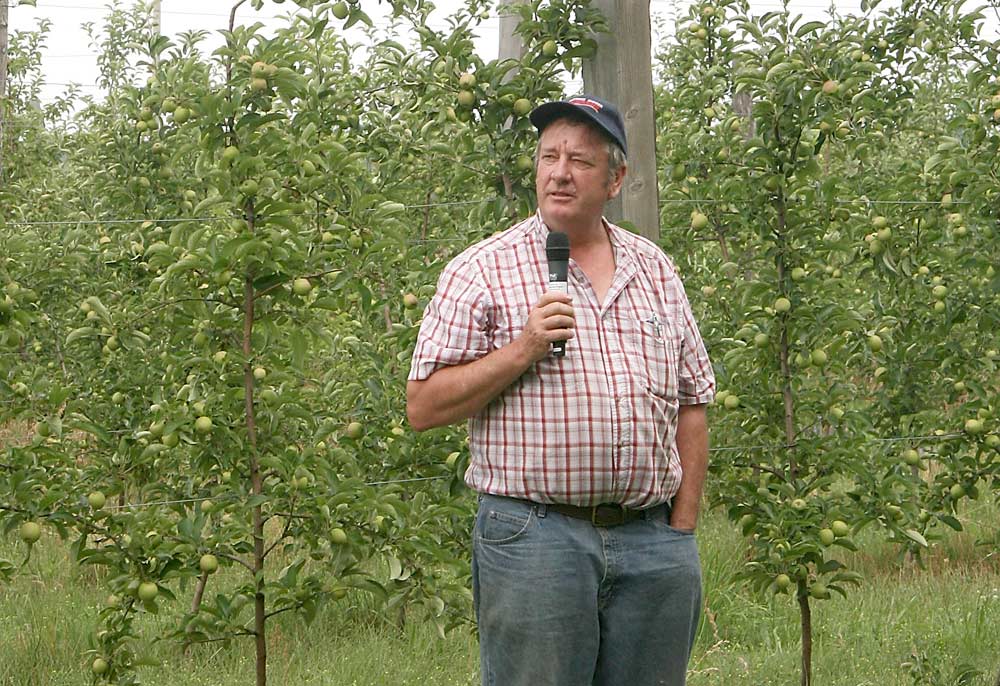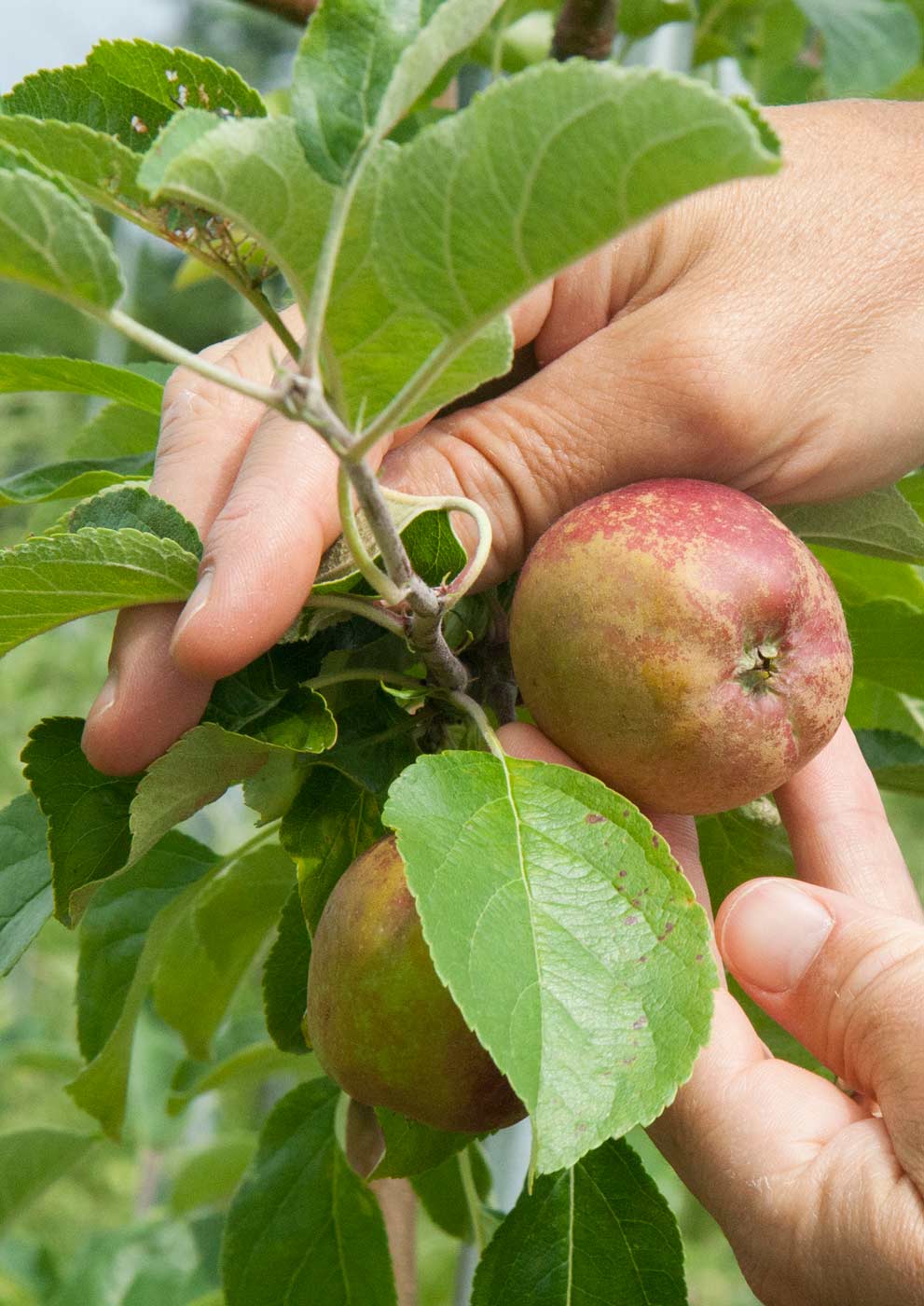
In the Northeast, organic apple orchards face tough competition from weeds, and more than one method of weed control appears to be needed, said Cornell University horticulturist Greg Peck, shown here on a July tour of his organic weed strip trials in Ithaca, New York. (Kate Prengaman/Good Fruit Grower)
If you listen carefully, you can hear the worms chewing,” grower Jim Bittner joked with a tour group visiting his organic apple block along the shore of Lake Ontario.
Jokes aside, he’s making a profit growing organically in Western New York, something believed to be nigh impossible for many years but is now gaining the interest of some growers.
Bittner says he doesn’t buy the organic consumer’s position that the fruit is better; he just likes the price premium.
“I don’t believe in it, but I do believe in growing for markets. If someone wants me to stand on my head while I’m doing it, I will.”
But in some ways, growing organically in the humid Northeast is still akin to growing apples standing on your head, according to Cornell University researchers who spoke about organic production at Bittner’s orchard as part of Cornell Cooperative Extension’s summer tour of innovative farms.
Growers who try their hand at it have to think both creatively and carefully about how to manage and market their fruit.
“We have conditions here in New York that are the ultimate challenge for organic growers, in terms of diseases and insects,” said Cornell University entomologist Art Agnello.
Organic pest management requires 10 times greater attention to detail than conventional production, he said, and even with optimum practices, there’s going to be some damage from pests like plum curculio and codling moth.
“We don’t recommend it for most people, but if you do it, you need to know where the fruit is going in the end.”
That is the secret to Bittner’s success.

Jim Bittner of Bittner-Singer Orchards talks about finding a profitable home for organic apples for the processing market in front of his organic GoldRush block during the Cornell Cooperative Extension Lake Ontario Fruit Summer Tour. (Kate Prengaman/Good Fruit Grower)
He sends the majority of the GoldRush apples harvested in this 4-acre block for processing, where a few pest blemishes don’t matter.
“People say they want organic, but the fact of the matter is they still want perfect. I’ll siphon a few off for CSAs, but for the most part these are processing apples,” Bittner said. “These won’t be wormy, but they will have some codling moth sting.”
The premium price for organic apples, even in the processing market, means that he’s planning to add another 10-acre block, planted with significant investment in a tall spindle system with trickle irrigation.
Bittner said the irrigation spurs critical growth in organic systems during the first few years. He uses cedar posts for the trellis, big green wood chips for mulch and tolerates his wife’s cats because they hunt the mice the mulch attracts.
The orchard today looks nothing like when Bittner first tried his hand at organic apples in the early 1990s, transitioning an old block of standard trees to sell fruit to a friend who wanted to make dried organic apples.
That block, and several other attempts to convert existing blocks into organic production, ultimately failed because the standard tree canopies were too hard to manage and the varieties lacked immunity to apple scab. But what he learned led to the well-designed organic system he has today, Bittner said in an interview after the tour.
The challenges
Cornell pathologist Kerik Cox praised the orchard setup: the choice of GoldRush, an apple scab-resistant variety similar to Golden Delicious, and the open, well-pruned canopy of the high-density system, which makes diseases easier to control.
“In terms of diseases, the best thing to do is start with an apple scab-resistant variety. If you don’t, it will be an uphill battle to disappointment,” Cox said. But disease resistance doesn’t mean you don’t have to spray. There’s still powdery mildew, fire blight and cedar apple rust to worry about — along with plenty of pests.
“People see this and think it isn’t sprayed,” Bittner said. In fact, he already sprayed it with sulfur four times, virus to combat codling moth three times and pyrethrum once, he said in mid-July.
In a high-pressure year, organic growers could spray several times a week and still not get complete control of powdery mildew, Cox said, even with the expensive products.
But, he said the formulations and recommendations for biological products like Serande, Double Nickel and Regalia seem to be getting better.
Cox also recommends that growers think about meaningful levels of control, not complete control. At 50 percent control of powdery mildew, for example, “you still have an ugly tree, but you’re not going to ruin the crop,” he said.
In terms of fire blight, organic growers may actually have one advantage, Cox said. The slower growth typical of organic orchards without the push of synthetic nitrogen means that fire blight also moves more slowly, and growers can often keep on top of shoot blight by pruning.
On the pest front, it’s important not to start too small, Agnello said. Mating disruption for codling moth loses effectiveness in blocks smaller than about 10 acres, he said. For plum curculio, the most challenging pest for organic growers today, Surround offers the best control, although it takes a lot of work.
His research showed that a complex organic management strategy using Entrust, Surround and mating disruption resulted in 50 percent clean fruit, Agnello said, compared with less than 20 percent clean fruit in the control blocks.
That’s why growing for a specific market, like Bittner, matters. Otherwise you risk spending too much on pesticides to be profitable.
“Before this block, on average, we lost money on organic, but I saw it as a learning thing. Hey, someday someone might force us to grow this way,” Bittner said, adding that he has learned a lot from his organic experience. “The worst thing is when you get people who don’t know how to grow apples who think they are going to do this. You have to be a good conventional grower to do this.”
The future

Modi apples show signs of russeting from copper sprays used to control fire blight in an organic rootstock trial planted at Cornell Orchards in New York. (Kate Prengaman/Good Fruit Grower)
There’s plenty more to learn. In addition to the insect and disease control experiments, Cornell horticulture professor Greg Peck has planted trials on organic weed control and rootstock performance.
“We need rootstocks that are able to work in high-density systems and that have high nutrient and water use efficiency so that the trees can be competitive with the ground cover, because in organic we typically have high weed cover,” Greg Peck said.
The NC-140 trial pairs about a dozen different rootstocks with Modi, an Italian variety that was selected because of its disease resistance. There are no results yet, as the trees are just in their third leaf. But this year, many of the fruit showed some russet, as a result of the copper sprays used to control fire blight organically, Peck said.
In terms of weed control, Peck is comparing the benefits of cultivation or mulch, along with organic herbicides or mowing, in a Honeycrisp block planted on Budagovsky 9 rootstocks in a tall spindle system.
“What we are seeing is that multiple weed control strategies are needed. Mulch is not enough. Cultivation alone is not enough,” he said.
Cultivation with an herbicide on top, however, seems to be working, especially compared to the adjacent control plot with no weed control.
Peck plans to follow the experiment for many years to see if there are meaningful changes in the soil quality, weed community composition, and of course, fruit production and quality as the orchard matures.
All that data will no doubt be valuable as the organic apple industry in the Northeast matures.
“For people asking, can it be done, can it be done at scale? Yeah, it can be. The challenges are you are going to have more cosmetic damage and you have to think more about what you are doing in advance. There is no silver bullet if a pest gets ahead of you,” Peck said. “You have to have a really good management plan and think creatively about what your control tactics are going to be. But several of our large scale, commercial, conventional growers say this is something we should try.” •
– by Kate Prengaman






Leave A Comment